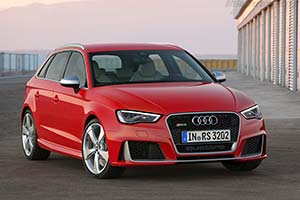
| Audi RS 3 Sportback |
| Article | Image gallery (18) | Specifications |

|
|
<< Prev Page 2 of 3 Next >> The driver of the new Audi RS 3 Sportback can choose between two automatic modes for the seven-speed S tronic or shift manually using the shift paddles on the steering wheel or the selector lever. The launch control system provides for optimal traction and minimal tire slip when sprinting from a standing start. The lower gears are sportily short; seventh gear is tall to reduce fuel consumption. A plug-connected angle drive connects the ultra-compact gearbox with the prop shaft - a design that displays intelligent lightweight construction down to the last detail. The quattro permanent all-wheel drive system transfers the power of the 2.5 TFSI to the road with supreme ease. Its central component is the electronically controlled, hydraulically activated multi-plate clutch. The newly developed part is mounted at the rear axle for reasons of axle load distribution. The multi-plate clutch uses software custom tailored for the Audi RS 3 Sportback. It distributes the available torque as needed to the front and rear axles in the blink of an eye. Depending on the driving style and coefficient of friction, between 50 and 100 percent of the available torque can be sent to the rear axle. The electric pump, which develops the necessary oil pressure of max. 38 bar, is highly efficient. It is activated immediately the instant road grip drops or the driver adopts a sportier style. The weight of the clutch was reduced by 1.4 kilograms (3.1 lb) versus the previous version by eliminating the pressure accumulator. Another example of targeted lightweight construction. Control of the multi-plate clutch is integrated into the Audi drive select system. With its very sport configuration, it uses all handling-relevant information, such as the steering angle. In dynamic mode and when the ESC Electronic Stabilization Control system is set to sport mode, power is transferred sooner and in greater amounts to the rear axle for even better handling, giving the new Audi RS 3 Sportback very agile and direct turn-in. This enables the driver to even perform controlled drifts on low-friction road surfaces. The front axle pulls the car back onto a straight line when exiting a bend. Torque vectoring makes the handling of the Audi RS 3 Sportback even more perfect. During fast cornering, it slightly brakes the interior wheels, which are under a reduced load. This enables both wheels on the axle to transfer more power to the road. Thanks to the difference in propulsive forces, the car turns slightly into the corner and supports the driver's sporty driving style. The chassis complements the dynamics of the drivetrain perfectly. Precisely guided by its sensitive steering, the new Audi RS 3 Sportback takes all types of corners quickly and stably. Its handling limits are very high and effortlessly manageable. The McPherson front suspension has been widened to a track of 1,559 millimeters (5.1 ft) and includes specially developed, high-strength aluminum pivot bearings. The standard progressive steering varies its ratio between 15.3:1 and 10.9:1 as a function of steering input. Its efficient, electromechanical servo boost works with an RS-typical characteristic. The rear axle, which as a track width of 1,514 millimeters (5.0 ft), is a four-link construction with rods of high-strength steel that handle the longitudinal and lateral forces separately. As with the front axle, these forces are directed to a subframe. The taut RS sport suspension lowers the body by 25 millimeters (1.0 in) compared with the A3 Sportback. The Audi magnetic ride adaptive damper system is available as an option. Its management is integrated into the standard Audi drive select dynamic handling system, which includes the modes comfort, auto, dynamic and individual. The dynamic, new top model of the A3 series rolls on 19-inch, cast aluminum wheels in five-arm rotor design with size 235/35 tires. Audi offers machine-polished 19-inch wheels in matt titanium look or high-gloss anthracite black. The top tire option includes size 255/30 tires up front and 235/35 at the rear. The internally ventilated brake discs measure 370 millimeters (14.6 in) in diameter at the front and 310 millimeters (12.2 in) at the rear. The front friction rings feature a weight-saving wave design and are perforated for maximum heat dissipation. Pins connect them to aluminum brake caps, and they are gripped by eight-piston fixed calipers painted black (red optional) with RS logos. One of the technologies that differentiate the new Audi RS 3 Sportback from its competitors are the optional carbon fiber-ceramic brake discs on the front axle. They also measure 370 millimeters (14.6 in) and are gripped by anthracite gray calipers. The Electronic Stabilization Control (ESC) offers a sport mode and can also be entirely deactivated with an extended push of a button. << Prev Page 2 of 3 Next >> |
| Article | Image gallery (18) | Specifications |
| All Cars - Contact us - Privacy Statement - Top | © 1998 - 2024 Ultimatecarpage.com |

